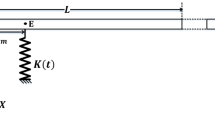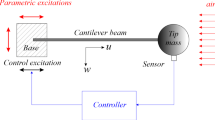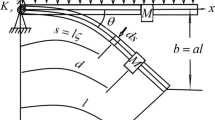Abstract
Purpose
The problem of parametric resonance of a base-excited cantilever beam has been studied both analytically and numerically. The support motion of the cantilever beam is generated by a feedback mechanism whereby the feedback signal is generated after modulating the cantilever tip motion with a harmonic time signal. This paper contributes a novel analytical technique for feedback-based parametric excitation. In the studied method, solely transverse displacement is given to the clamped end. It is different from the other methods, where axial displacement is also provided as parametric pumping.
Method
A new analytical method, not requiring any small parameter in the equation of motion, has been proposed to obtain stability boundary in the parametric space. Harmonic balance is carried out in the temporal domain for stability analysis. For numerical study, discrete element method is used.
Results
Numerical analysis is carried out to study unstable and stable behaviour for the applied parametric excitation. The numerical simulation results have been found out to be in excellent agreement with the outputs of analytical study.






Similar content being viewed by others
References
Rajasekar S, Sanjuan MAF (2016) Parametric resonance. Springer International Publishing, New York, pp 261–291
Chand R, Behera P, Pradhan M, Dash P (2019) Parametric stability analysis of a parabolic-tapered rotating beam under variable temperature grade. J Vib Eng Technol 7(1):23–31
Alevras P, Theodossiades S, Rahnejat H (2017) Broadband energy harvesting from parametric vibrations of a class of nonlinear mathieu systems. Appl Phys Lett 110(23):233901
Jia Y, Yan J, Soga K, Seshia AA (2014) A parametrically excited vibration energy harvester. J Intell Mater Syst Struct 25(3):278–289
Ecker H, Pumhössel T (2012) Vibration suppression and energy transfer by parametric excitation in drive systems. Proc Inst Mech Eng Part C J Mech Eng Sci 226(8):2000–2014
Zhang W, Turner KL (2005) Application of parametric resonance amplification in a single-crystal silicon micro-oscillator based mass sensor. Sens Actuators A 122(1):23–30
Yie Z, Miller NJ, Shaw SW, Turner KL (2012) Parametric amplification in a resonant sensing array. J Micromech Microeng 22(3):035004
Iwatsubo T, Saigo M, Sugiyama Y (1973) Parametric instability of clamped-clamped and clamped-simply supported columns under periodic axial load. J Sound Vib 30(1):65–IN2
Chakraborty G, Mallik A (1998) Parametrically excited non-linear traveling beams with and without external forcing. Nonlinear Dyn 17(4):301–324
Ikeda T, Murakami S (1999) Dynamic response and stability of a rotating asymmetric shaft mounted on a flexible base. Nonlinear Dyn 20(1):1–19
Huang Y, Liu A, Pi Y, Lu H, Gao W (2017) Assessment of lateral dynamic instability of columns under an arbitrary periodic axial load owing to parametric resonance. J Sound Vib 395:272–293
Pradhan M, Dash P (2016) Stability of an asymmetric tapered sandwich beam resting on a variable pasternak foundation subjected to a pulsating axial load with thermal gradient. Compos Struct 140:816–834
Rhoads JF, Miller NJ, Shaw SW, Feeny BF (2008) Mechanical domain parametric amplification. J Vib Acoust 130(6):061006
Neumeyer S, Thomsen JJ (2012) Macroscale mechanical domain parametric amplification: superthreshold pumping and optimal excitation parameters. In: EUROMECH Colloquium 532: 1st International Colloquium on Time periodic systems (TPS). Current trends in theory and application. Technische Universität Darmstadt
Prakash G, Raman A, Rhoads J, Reifenberger RG (2012) Parametric noise squeezing and parametric resonance of microcantilevers in air and liquid environments. Rev Sci Instrum 83(6):065109
Moreno-Moreno M, Raman A, Gomez-Herrero J, Reifenberger R (2006) Parametric resonance based scanning probe microscopy. Appl Phys Lett 88(19):193108
Anderson TJ, Balachandran B, Nayfeh AH (1994) Nonlinear resonances in a flexible cantilever beam. J Vib Acoust 116(4):480–484. https://doi.org/10.1115/1.2930452
Dugundji J, Mukhopadhyay V (1973) Lateral bending-torsion vibrations of a thin beam under parametric excitation. J Appl Mech 40(3):693–698
Xia G, Fang F, Zhang M, Wang Q, Wang J (2019) Performance analysis of parametrically and directly excited nonlinear piezoelectric energy harvester. Arch Appl Mech 89:1–20
Chiba M, Shimazaki N, Ichinohe K (2014) Dynamic stability of a slender beam under horizontal-vertical excitations. J Sound Vib 333(5):1442–1472
Zavodney LD, Nayfeh A (1989) The non-linear response of a slender beam carrying a lumped mass to a principal parametric excitation: theory and experiment. Int J Non-Linear Mech 24(2):105–125
Feng Z, Lan X, Zhu X (2007) Principal parametric resonances of a slender cantilever beam subject to axial narrow-band random excitation of its base. Int J Non-Linear Mech 42(10):1170–1185
Neves A, Simões F, Da Costa AP (2016) Vibrations of cracked beams: discrete mass and stiffness models. Comput Struct 168:68–77
Acknowledgements
First author is very grateful to Anand Kumar Agrawal for his useful discussion regarding discrete element method and its simulation.
Funding
Not applicable.
Author information
Authors and Affiliations
Corresponding author
Ethics declarations
Conflict of interest
The authors declare that they have no conflict of interest.
Additional information
Publisher's Note
Springer Nature remains neutral with regard to jurisdictional claims in published maps and institutional affiliations.
Appendix
Appendix
 , vectors of transverse displacement and rotation of blocks, vectors for transverse forces and moments acting on blocks are given as
, vectors of transverse displacement and rotation of blocks, vectors for transverse forces and moments acting on blocks are given as

Matrices representing mass, length, mass moment of inertia of the blocks and stiffness matrix are diagonal.
Matrices, \({{\textit{\textbf{A}}}}\) and \({{\textit{\textbf{B}}}}\) have the form like,
Here, as displacement is applied to the clamped end of cantilever beam, \(y_1 \ne 0\) and \(\theta _1=0\). Variables related to the first block are not included in the vectors for the system of equation. As the translational and rotational motions of all the rigid blocks represent deflection of the cantilever beam, compatibility condition must be followed.

Moments acting on the rigid blocks and their rotations are related as,

Substituting the above expression for  , equation of moment balance, (29), can be written as,
, equation of moment balance, (29), can be written as,

From the (33),

Using the expression for  , (34) can be written in following format so that,
, (34) can be written in following format so that,  will only be the dependent variable.
will only be the dependent variable.

Coefficients of the system of equations, (36) are,

(36) can be further simplified as,

where \(\varvec{\alpha }=(\varvec{\beta _{1}}-{{\textit{\textbf{A}}}}^{-1} {{\textit{\textbf{m}}}})^{-1}\).
Rights and permissions
About this article
Cite this article
Jani, N., Chakraborty, G. Parametric Resonance in Cantilever Beam with Feedback-Induced Base Excitation. J. Vib. Eng. Technol. 9, 291–301 (2021). https://doi.org/10.1007/s42417-020-00226-1
Received:
Revised:
Accepted:
Published:
Issue Date:
DOI: https://doi.org/10.1007/s42417-020-00226-1




